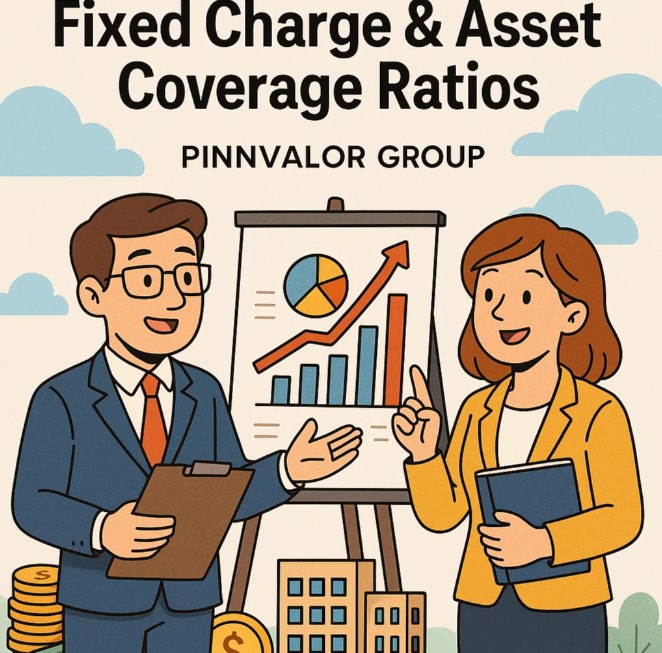
The Investor’s Guide to Fixed Charge & Asset Coverage Ratios
Investing wisely requires more than just looking at profits or stock prices. To truly understand a company’s financial health and risk profile, investors need to dive deeper into financial ratios that highlight the company’s ability to meet its obligations. Two such critical ratios are the Fixed Charge Coverage Ratio and the Asset Coverage Ratio. These ratios help investors assess whether a company can reliably cover its fixed costs and debts, reducing the risk of financial distress.
This guide will walk you through what these ratios mean, how to calculate them, and why they matter for investment decisions.
Can a company’s assets and earnings protect your investments?
Coverage ratios are the financial safety nets that reveal a company’s true ability to meet its fixed charges and debt obligations. Understanding these ratios helps investors make smarter, risk-aware decisions.
What Are Coverage Ratios?
Coverage ratios are financial metrics that measure a company’s ability to service its debt and fixed obligations. They provide insight into how comfortably a firm can pay interest, lease payments, debt installments, and other fixed charges from its operating income or available assets.
Among many coverage ratios, the Fixed Charge Coverage Ratio and the Asset Coverage Ratio are particularly useful for investors seeking to understand both short-term operational risks and long-term solvency.
Fixed Charge Coverage Ratio: What It Is and Why It Matters
Definition
The Fixed Charge Coverage Ratio (FCCR) measures a company's ability to cover all fixed financial charges, including interest expenses, lease payments, and other contractual fixed costs, from its earnings.
Formula
Fixed Charge Coverage Ratio = (EBIT + Fixed Charges Before Tax) / (Fixed Charges + Interest Expense)
- EBIT (Earnings Before Interest and Taxes): Reflects operating income before fixed charges.
- Fixed Charges: These include lease payments, insurance, and other mandatory payments.
Interpretation
- Ratio > 1: The company generates enough earnings to comfortably cover its fixed charges.
- Ratio = 1: Earnings just cover the fixed charges — a potential warning sign.
- Ratio < 1: The company may struggle to meet fixed obligations, indicating financial stress.
Why Investors Should Care
Fixed charges often represent contractual obligations that must be paid regardless of business performance. A strong FCCR indicates less risk of default or liquidity crunch, which protects investor capital and supports stable dividend payments.
Asset Coverage Ratio: What It Tells Investors
Definition
The Asset Coverage Ratio evaluates whether a company’s tangible assets are sufficient to cover its total debt and preferred stock, serving as a measure of collateral strength.
Formula
Asset Coverage Ratio = (Total Tangible Assets – Current Liabilities) / (Total Debt + Preferred Stock)
- Tangible Assets: Physical assets like property, plant, equipment, and inventory.
- Current Liabilities: Short-term obligations.
- Debt & Preferred Stock: Long-term liabilities and equity obligations.
Interpretation
- Higher Ratio (>1): Strong asset backing, implying safety for creditors and lower risk.
- Lower Ratio (<1): Weak asset coverage, potentially risky for investors as assets might not cover obligations in liquidation.
Importance for Investors
This ratio is vital for bondholders and preferred shareholders since it indicates the liquidation value available to cover debts. Investors interested in safer, asset-backed securities often look for companies with strong asset coverage.

Comparing Fixed Charge and Asset Coverage Ratios
| Aspect | Fixed Charge Coverage Ratio | Asset Coverage Ratio |
|---|---|---|
| Focus | Ability to meet fixed financial charges | Ability of assets to cover debt and preferred stock |
| Measures | Income vs fixed expenses | Tangible assets vs liabilities |
| Timeframe | Operational/short-term ability | Long-term solvency and liquidation safety |
| Key Users | Lenders, creditors, investors | Creditors, bondholders, risk-averse investors |
Together, these ratios provide a comprehensive picture of a company’s financial strength from operational and asset perspectives.
How Investors Can Use These Ratios in Decision Making
- Risk Assessment: Low coverage ratios signal higher risk of default or financial distress, prompting investors to reconsider or demand higher returns.
- Portfolio Diversification: Investors may prefer companies with strong coverage ratios to add stability to their portfolios.
- Credit Analysis: Bond investors particularly rely on these ratios to evaluate creditworthiness.
- Valuation: Companies with healthy coverage ratios often enjoy better valuation multiples due to perceived lower risk.
Example Calculation
Imagine Company ABC has:
- EBIT = $500,000
- Fixed Charges Before Tax = $50,000
- Interest Expense = $30,000
- Total Tangible Assets = $2,000,000
- Current Liabilities = $300,000
- Total Debt = $1,000,000
- Preferred Stock = $200,000
Fixed Charge Coverage Ratio:
(500,000 + 50,000) / (50,000 + 30,000) = 550,000 / 80,000 = 6.875
Asset Coverage Ratio:
(2,000,000 – 300,000) / (1,000,000 + 200,000) = 1,700,000 / 1,200,000 = 1.42
Interpretation:
- FCCR of 6.875 indicates strong earnings to cover fixed charges.
- Asset coverage of 1.42 suggests solid tangible asset backing for debt and preferred stock.
Final Thoughts
For investors, understanding Fixed Charge Coverage and Asset Coverage Ratios is more than just crunching numbers — it’s about evaluating the financial durability and risk profile of companies they invest in. These ratios shed light on the company’s ability to withstand financial stress and protect investor capital.
Before making any investment, consider these ratios alongside other financial metrics and qualitative factors to make balanced, informed decisions.
